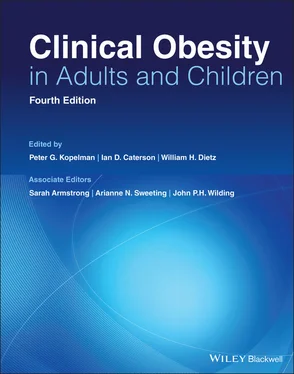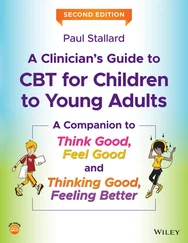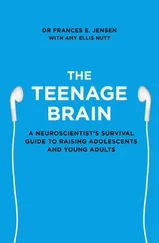Clinical Obesity in Adults and Children
Здесь есть возможность читать онлайн «Clinical Obesity in Adults and Children» — ознакомительный отрывок электронной книги совершенно бесплатно, а после прочтения отрывка купить полную версию. В некоторых случаях можно слушать аудио, скачать через торрент в формате fb2 и присутствует краткое содержание. Жанр: unrecognised, на английском языке. Описание произведения, (предисловие) а так же отзывы посетителей доступны на портале библиотеки ЛибКат.
- Название:Clinical Obesity in Adults and Children
- Автор:
- Жанр:
- Год:неизвестен
- ISBN:нет данных
- Рейтинг книги:5 / 5. Голосов: 1
-
Избранное:Добавить в избранное
- Отзывы:
-
Ваша оценка:
- 100
- 1
- 2
- 3
- 4
- 5
Clinical Obesity in Adults and Children: краткое содержание, описание и аннотация
Предлагаем к чтению аннотацию, описание, краткое содержание или предисловие (зависит от того, что написал сам автор книги «Clinical Obesity in Adults and Children»). Если вы не нашли необходимую информацию о книге — напишите в комментариях, мы постараемся отыскать её.
A comprehensive and incisive exploration of obesity in society and the clinical setting Clinical ;Obesity in Adults and Children
Clinical Obesity in Adults and Children — читать онлайн ознакомительный отрывок
Ниже представлен текст книги, разбитый по страницам. Система сохранения места последней прочитанной страницы, позволяет с удобством читать онлайн бесплатно книгу «Clinical Obesity in Adults and Children», без необходимости каждый раз заново искать на чём Вы остановились. Поставьте закладку, и сможете в любой момент перейти на страницу, на которой закончили чтение.
Интервал:
Закладка:
Table of Contents
1 Cover
2 Title Page
3 Copyright Page
4 List of Contributors
5 Preface
6 Dedication
7 List of Abbreviations
8 1 Obesity 1 Obesity – Introduction Obesity as a public health problem Lower limits of BMIs in non‐Caucasians? Morbidity burden starts at much lower BMIs Obesity epidemic starts in the early 1980s The global epidemic gets underway Abdominal obesity Different regional societal burdens of obesity with abdominal obesity Historical analyses of contributors to obesity The burden of obesity The economic impact of excess weight gain Conclusions References 2 The Epidemiology and Social Determinants of Obesity Introduction Defining excess body fat Adult obesity Childhood obesity Global obesity Social determinants of obesity Conclusions References
9 2 Causes of Obesity 3 Fetal and Infant Origins of Obesity Background Assessing obesity in children Conceptual frameworks Study designs Developmental risk factors Biology and mechanisms Estimating population attributable risks Implications for policy and practice Acknowledgments References 4 Genes and Obesity Introduction Historical perspective Gene–environment interactions Evidence for the heritability of fat mass Adoption studies Twin studies Pleiotropic obesity syndromes Prader–Willi syndrome Albright hereditary osteodystrophy Bardet–Biedl syndrome Molecular mechanisms involved in energy homeostasis Rodent models of obesity Leptin–melanocortin pathway Monogenic obesity syndromes affecting the leptin‐melanocortin pathway Response to leptin therapy Leptin receptor deficiency POMC deficiency Prohormone convertase 1 deficiency MC4R deficiency Conclusions References 5 Bias, Stigma, and Social Consequences of Obesity Social consequences for adults Social consequences for youth Impact of weight stigma on health Interventions to prevent and reduce weight stigma Conclusion References 6 Ecology, Protein Leverage, and Public Health Introduction An ecological view of nutrition Human macronutrient regulation Human nutritional ecology Bringing it all together: complex systems Conclusions References 7 The Living Environment and Physical Activity From the environment to behaviors to obesity Physical activity and health Physical activity and weight gain Spatial variation in obesity Measuring attributes of the built environment Relations between the built environment, physical activity, and obesity Research trends Changes in the urban environment Conclusion References 8 Psychobiology of Obesity Setting the scene Can obesity be managed through behavior change? Complex bio‐cultural system of appetite control The bio‐behavioral appetite system: tonic and episodic processes The satiety cascade: homeostatic and hedonic processes Individual variation in susceptibility to overconsumption: phenotypes for appetite control Satiety responsiveness and the low satiety phenotype Sensitivity to food reward Compensation in response to exercise Implications for the treatment and prevention of obesity and future directions Closing comments References 9 Energy Balance and Body Weight Homeostasis Introduction Basic concepts and principles in human energetics Control of food intake Autoregulatory adjustments in energy expenditure Integrating intake and expenditure References
10 3 Obesity as a Disease 10 Obesity, Ectopic Fat and Type 2 Diabetes Introduction Epidemiology Not all fat is the same Metabolically healthy obese and metabolically unhealthy lean Pathogenesis of visceral and ectopic fat accumulation Factors affecting body fat distribution Linking ectopic fat accumulation to diabetes How can we measure VAT and ectopic fat Therapy Conclusion References 11 Obesity and Dyslipidemia, Importance of Body Fat Distribution Introduction Limitations to fat storage Hyperlipidemia in relation to adiposity The dynamics and difference of adipose tissue depot functions in the body in relation to hyperlipidemia Associations between plasma lipids and lipoproteins and discrete fat depots References 12 Obesity and Fertility Introduction References 13 Metabolic Syndrome and Metabolic Dysfunction‐Associated Fatty Liver Disease Introduction Pathogenesis of MS Pathogenesis and clinical implications of MAFLD Association between MS and MAFLD Pathological link between MAFLD and MS Inflammation, linked with MS, is the main determinant in progression from NAFLD to NASH Increased inflow of FFAs and de novo hepatic lipogenesis are the main determinants of MAFLD Oxidative and ER stresses are involved in the association between MS and MAFLD Adiponectin, a critical link between MS and MAFLD Role of gut microbiota in the crosstalk between MAFLD and MS Association of sarcopenia with MS and MAFLD Medications for the treatment of MAFLD/NASH Role of SGLT2 inhibitors Role of GLP1 receptor agonists Conclusions References 14 Cardiovascular Consequences Introduction Epidemiology Risk associations in people with the prevalent disease – obesity paradox or confounding? Genetics of obesity and cardiovascular outcomes Mechanisms Interventions: weight loss benefits in CV medicine Timing of weight loss benefits on metabolic versus ASCVD outcomes Summary References 15 Obstructive Sleep Apnea Sleep‐disordered breathing Sleep‐disordered breathing: epidemiology Sleep‐disordered breathing: clinical aspects Sleep disordered breathing: treatment Conclusion References 16 Obesity and Cancer General mechanisms linking obesity and cancer Colorectal cancer Breast cancer Stomach cancer Liver cancer Esophageal cancer Pancreatic cancer Ovarian cancer Intentional weight loss Early life risk factors for cancer Dietary characteristics Comprehensive integration of the evidence‐base Disclosure References
11 4 Management of Adult Obesity 17 A Practical Approach to Contemporary Obesity Management Introduction Obesity Weight loss Weight control in the age of SARs‐CoV‐2 coronavirus (COVID‐19) Aims of obesity treatment Current obesity treatment options Where should these interventions be available/delivered? Summary Appendix A References 18 Dietary Management of Obesity Dietary treatment of obesity Energy deficit Energy density Low‐fat diets Plant‐based diets Mediterranean diets Low energy diets Partial meal replacement therapy Low carbohydrate or higher protein diets Ketogenic diets Very low energy (calorie) diets (VLEDs) Intermittent energy restriction The less restrictive dieting approach Ultra‐processed food Sugar sweetened beverages Basic principles Nutrition in practice Portion sizes and eating frequency Maintenance and/or success Clinical guidelines Conclusion References 19 The Behavioral Treatment of Obesity Behavioral treatment Components of behavioral treatment Dietary options for weight loss Physical activity Structure of behavioral treatment Short‐ and long‐term weight losses Strategies to improve long‐term weight losses New behavioral approaches Implementation and dissemination of behavioral treatment Conclusion References 20 Role of Exercise and Physical Activity in Promoting Weight Loss and Weight Loss Maintenance Introduction Operational definitions Relationships between PA levels and body mass Relationships between sedentary behavior and body mass Energy balance considerations Exercise and weight reduction Resistance training Exercise factors that may influence magnitude of weight loss Can walking interventions aid weight loss? Using other measures of excess weight to determine the metabolic benefit of exercise Biological response to weight loss from any type of intervention Evidence for metabolic adaptations to exercise Heterogeneity in exercise response and the concept of responders vs. nonresponders Use of exercise/PA as a tool to achieve weight loss maintenance (WLM) Conclusions References 21 Adjunctive Therapy, Including Pharmacotherapy Introduction and general principles Classification of obesity medication Currently approved drugs Potential future targets including medications not licensed for use in obesity The use of anti‐obesity drug therapy post‐bariatric surgery Conclusion References 22 The Management of Obesity Introduction The evolution of surgical technique Overview of outcomes from bariatric procedures Weight loss outcomes from bariatric surgery Changes in health after bariatric surgery Survival after bariatric surgery The Swedish Obese Subjects (SOS) study Safety of bariatric surgery Conclusion References 23 Weight Loss Maintenance and Weight Cycling What is weight loss maintenance and how is it defined? What lifestyle characteristics are associated with weight maintenance success? Interventions
Читать дальшеИнтервал:
Закладка:
Похожие книги на «Clinical Obesity in Adults and Children»
Представляем Вашему вниманию похожие книги на «Clinical Obesity in Adults and Children» списком для выбора. Мы отобрали схожую по названию и смыслу литературу в надежде предоставить читателям больше вариантов отыскать новые, интересные, ещё непрочитанные произведения.
Обсуждение, отзывы о книге «Clinical Obesity in Adults and Children» и просто собственные мнения читателей. Оставьте ваши комментарии, напишите, что Вы думаете о произведении, его смысле или главных героях. Укажите что конкретно понравилось, а что нет, и почему Вы так считаете.











